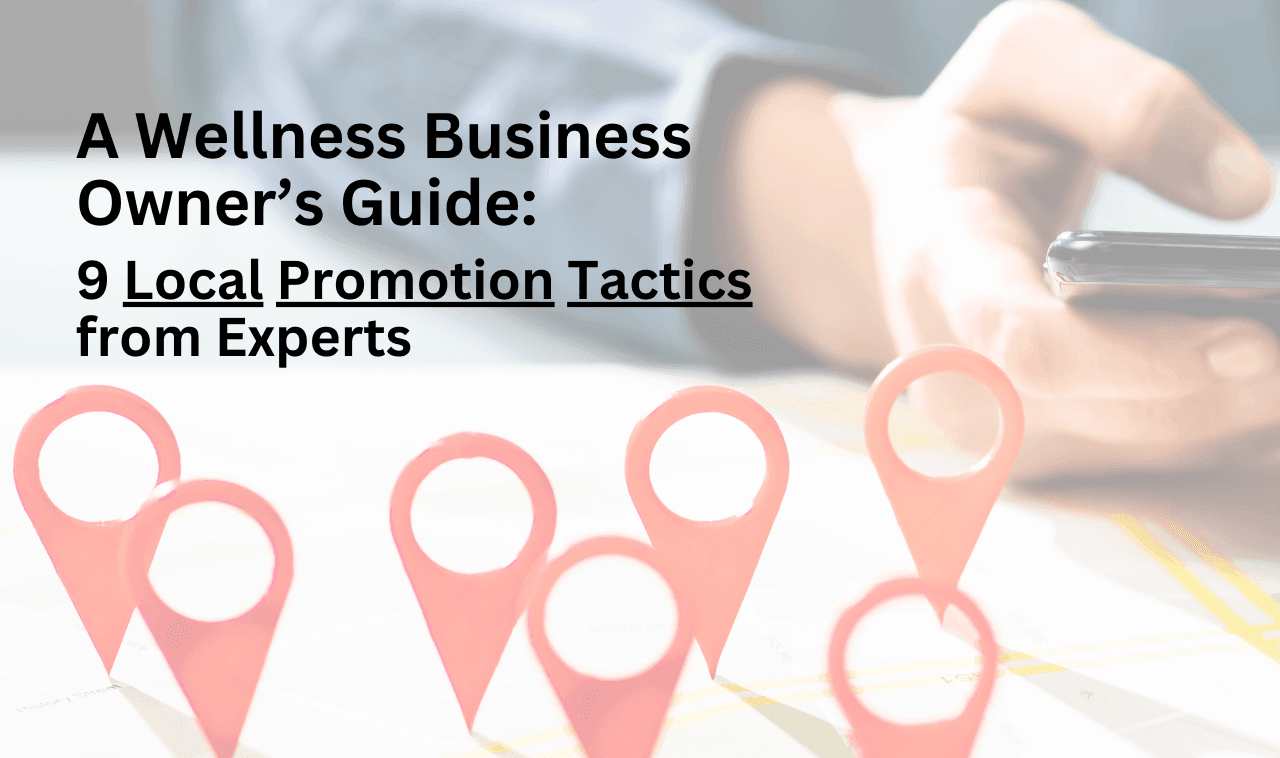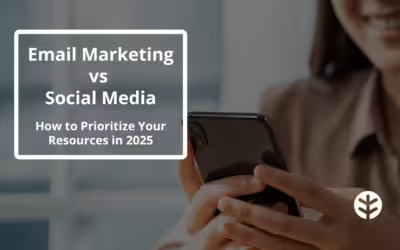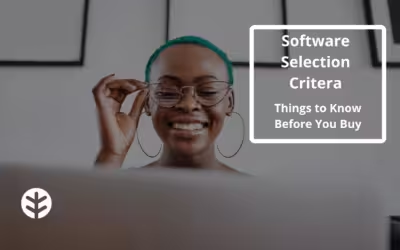Table of Contents:
Understanding Your Local Market
Before starting your local marketing efforts, you’ll want to understand your local market well to ensure you’re reaching your target audience with your promotions. There are many ways to get up to speed if you’re new to the area or owning a wellness business. This list will help you get started:
- Online Research: This is an easy way to learn what kinds of businesses are in the neighborhood and the demographics of the people who live and work nearby. You can also check out the websites of surrounding businesses to get a feel for the area and how they promote themselves.
- Footwork: Give yourself the gift of a field trip so you can visit the area around your wellness business. Stop into shops, try the lunch at the corner deli, and notice what you see and hear.
- Connect: Talk with your current clients and find out how they heard about your business. Call others nearby to see if they’re open to sharing what promotions have worked for them.
Get a Lay of the Land: Competitive Analysis
Once you’ve taken the time to understand your local market, it’s time to go a little deeper and do a competitive analysis of your local competitors to help you identify how to set yourself apart. In addition to direct competitors with similar offerings to yours, competitors could also be related businesses that interest your target audience.
For example, if you own a yoga studio with a Pilates studio nearby, that could be considered an indirect competitor as a client could choose yoga or Pilates on their Saturday mornings. You’ll want to consider the following components when you do your analysis:
- Identify the Competition: The first thing you’ll want to do is list your direct and indirect competitors. These organizations have similar offerings or offerings that appeal to the same audience as yours.
- Research & Evaluate: Once you have your list, you can start researching them and creating profiles highlighting their services, pricing, reputation, reviews, and more so you can identify similarities and differences.
- Discover Your Competitive Advantage: Once you’ve learned all about your competition, you can use this information to determine how you’ll stand out. You can leverage this in your local marketing efforts.
- Use Competitive Info to Avoid Pitfalls: If your research shows that a competitor has been struggling with poor customer service or other issues, this is your chance to learn. You can set yourself apart simply by focusing on providing excellent service and highlighting this in your local advertisements.
Affordable Local Marketing Tactics
You may have shied away from local marketing efforts, thinking they would be cost-prohibitive. However, there are many free and affordable local marketing tactics that you can create and implement fairly quickly with an investment of time and creativity.
Social Media Marketing
Simply put, social media marketing uses social media platforms like Instagram, Facebook, and TikTok to interact with current and prospective clients to build your overall brand. This will drive web traffic, typically leading to growing your community and sales. The list below outlines a few tactics you can implement:
- Engage: By posting on social media regularly, you’ll increase overall engagement with your audience. Determine a realistic schedule for you and commit to it. It could be as simple as Fitness Tip Fridays or Wellness Wednesdays.
- Inform: Social media is the perfect way to share your offerings regularly, but you can also update your audience on time-sensitive information. For example, share a pop-up yoga class on the first warm and sunny day in your area.
- Encourage Sharing: By creating locally relevant hashtags or having contests, your audience will join in – they’re your biggest fans, so allow them to help you grow.
- Observe: Check out what other wellness businesses are doing on social media so you can learn how to set yourself apart. Notice what types of posts get the most engagement. Play around and see what works for you.
Local SEO
In basic terms, SEO is a continuous process of enhancing your website to improve its organic search visibility.
This matters because you want to appear at the top of the search results when people search for products you offer, services you provide, and topics related to your business. The primary aim of SEO is to draw visitors to your website, who will then turn into customers, clients, or a recurring audience.
Local SEO is a subset of SEO for businesses with a physical location that serves that specific geographic area and relies on people in that location for revenue. The focus is optimizing a business’s online presence to attract more clients from relevant local searches. So, if you’re a brick-and-mortar pilates studio that relies on people in the neighborhood to become members, you should care about local SEO. Let’s explore the essential components of any local SEO strategy:
- Local Keyword Research
- Create Location Pages
- Strong Google Business Profile
- Collect Google Reviews
Local Keywords
Local keywords are specific phrases that include location-based terms, which people use when searching for services, products, or information in a specific area. These can include the name of the city, neighborhood, or even specific landmarks. For example, “yoga classes in downtown Saint Paul” or “Minneapolis yoga studio near me.”
Local keywords are essential to any local SEO strategy for many reasons:
- Targeted Reach: Local keywords help you target customers in your specific geographic area. This is particularly important for small businesses that rely on local clientele.
- Reduced Competition: By focusing on local search terms, you compete against fewer businesses than you would on a national or global level. This can increase your chances of ranking higher in search engine results for those specific keywords.
- High Conversion Rates: Searches with local intent tend to have higher conversion rates. People searching for a specific type of business within their vicinity are more likely to make a purchase decision or visit the location. For example, someone searching for “yoga classes near me” is likely looking to attend a class soon.
- Google My Business Optimization: Using local keywords can also enhance your Google My Business listing, which is critical for local SEO. When your business listing is optimized with the same local keywords that potential customers are searching for, it increases your visibility on Google Maps and local search results.
- Voice Search Optimization: With the rise of mobile and voice search, local keywords have become even more crucial. Voice searches are often location-based, like asking for “the nearest yoga studio.”
Landing Pages for Specific Locations
Location landing pages are individual web pages specifically designed to represent a particular branch or location of a business that has multiple outlets or serves multiple areas.
Each page is typically dedicated to a specific geographic area and contains tailored content relevant to that location, including address, contact information, localized services, and potentially customer testimonials or reviews.
Location pages for small businesses with multiple locations or service areas are essential for local SEO success for reasons such as:
- Local Relevance: Each landing page allows a business to cater content specifically to a local audience. This means providing details that are directly relevant to customers in that area, such as local promotions, events, or community involvement.
- Improved Search Engine Rankings: Optimizing each landing page with local keywords and location-specific information increases the chances of ranking higher in local search results. Search engines like Google often prioritize content that is most relevant to a user’s location-based query.
- Enhanced User Experience: Users often look for location-specific information like business hours, contact details, or directions.
- Backlink Opportunities: Location-specific pages can attract backlinks from local sources such as community websites, local news outlets, or blogs. These backlinks not only drive traffic but also enhance the local relevance of your business in the eyes of search engines.
Optimize Your Google Business Profile
A Google Business Profile (formerly known as Google My Business) is a free tool provided by Google for businesses to manage their online presence across Google, including Search and Maps. By creating and optimizing your GBP, you showcase your business and make it easier for customers to find you.
Use the following checklist to optimize your profile:
- Verify your listing
- Complete every section
- Choose the right business category
- Include keywords
- Add photos and/or videos
- Manage and respond to reviews
- Keep information current
- Enable messaging
- Utilize the Q&A feature
Encourage Google Reviews
Google reviews are crucial for local search because they influence both the business’s online reputation and its search engine rankings. Reviews contribute significantly to a business’s local SEO as they provide valuable signals to search engines about its relevance and trustworthiness in specific localities.
Here are some suggestions for ways to ask your customers for reviews:
- Just Ask: Often, the simplest way to get reviews is to ask. Encourage your staff to request reviews from customers at the end of their visit or transaction, especially if they’ve received positive feedback in person.
- Follow-Up Emails: After a purchase or service, send a follow-up email thanking customers for their business and kindly ask them to leave a review. Provide a direct link to your Google My Business listing to make the process as easy as possible.
- Incentivize: Offer small incentives for customers who leave a review. This could be a discount on a future purchase, a small freebie, or entry into a contest. It’s important, however, to ensure that you are incentivizing reviews, not just positive reviews, as it must be kept fair and honest.
- Utilize Signage: Place signs in your business location that encourage customers to leave a review. Include QR codes that link directly to your review page to simplify the process.
- Respond to Reviews: Respond to reviews, particularly negative ones, to show that you value customer feedback. This demonstrates your commitment to customer satisfaction and can encourage others to share their experiences.
- Make it Easy: Ensure your Google My Business profile is accurate, claimed, and verified, making it easier for customers to find where to leave a review.
Local Email Campaigns
Local email campaigns are an impactful, low-cost way to directly reach your audience after establishing a segmented email list. Here are some examples of effective email campaign ideas for local businesses for inspiration:
- New Offering Promotion: Whether you’re opening a new studio or adding new services, this is a way to generate excitement with your audience. You can tie in locally relevant content. For example, you can email your community about an outdoor class at a nearby park.
- Ask for Feedback: Create a segment from your email list of your most loyal clients and send a request for reviews. This will help build your brand and attract new clients. Your loyal clients will feel good supporting you.
- Use a Locally Relevant Subject Line: Are any significant seasonal events coming up? To draw your audience in, send an email tying your offerings to these or other happenings in your area.
Get Your Local SEO Checklist for Small Business Success
Engage with Your Community
In addition to helping to build your wellness business, engaging with your community can help you develop real connections in your area. Below are some ideas to help you get started with your own community-building efforts:
- Create Community-Related Offerings: What other activities are popular in your area? Does your city hold any marathons or bike races? After a big event, you could offer a special class for runners or cyclists.
- Go Offsite: Instead of always hosting services at your location, try a field trip. For example, how about a workshop at the library? You could schedule this for a time when a wellness author is doing a reading. The sky’s the limit!
- Participate: Take a break from work and get out there. Join a walking group or regularly visit businesses in the area. You’ll organically build engagement while supporting your community.
Local Advertising Ideas to Grow Your Small Business
In this section, we’ll discuss more local advertising ideas to enhance and grow your business. This includes paid ads to boost your local marketing, especially if your business is new.
Local Social Media Ads
As the name implies, paid social media ads are the ones you pay for – this isn’t as expensive as you might think. You control the spending, so you can get started with a $10 or $100 commitment, depending on your budget.
A significant advantage is that you can control who sees your ad based on various factors, including location, to ensure you reach your local audience. Build your business by trying these tactics:
- Geo-Targeted Ads: One of the most effective ways to promote workshops, classes, or events is by advertising to people in a specific location.
- Local Hashtag Campaigns: Start adding locally relevant hashtags to all your social media posts and encourage your clients and followers to use them. Consider a contest to drive up initial excitement.
- Client Testimonials: Who doesn’t love a success story? Share your client stories on social media and tag your clients so their circles can read about their success and possibly give your offerings a try themselves.
List Your Business in Local Directories
Have you ever searched Google for a nearby coffee shop and found yourself on Yelp? If so, you’ve visited a local directory. Local directories are websites that feature details about businesses and other organizations that typically include contact info, services, images, and reviews.
Other common examples are Google Business and Yellowpages. You’ll want to add your wellness business to local directories to increase your discoverability online. Below are key insights to consider:
- Backlinks: These are links that take you from one page to another, and since Google sees each one as a “vote,” the more you have, the higher your business will be in Google searches. You can build your backlinks by partnering with other wellness professionals and businesses to share each other’s links and build each other up over time.
- Niche Local Directories: Just because something is popular doesn’t mean it’s right for your business. Google likes businesses in your area to see which local directories Google “rewards” by displaying those results at the top. These might be best for your local advertising compared to the more popular options we’ve shared.
- Credibility: Besides improving your Google rankings, adding your wellness business to local directories will help you build credibility and overall brand with your audience.
Geographically Targeted Google Ads
Think about the last time you were in a new area and needed to find a place to eat. You may Google “Mexican food near me,” with several local options popping up.
The restaurants at the top of the list likely used Google Maps Ads, also known as local search ads. Here are a few tips to get the most out of this type of advertising:
- Perfect Your Intro: Give readers a quick and upbeat description of your services and anything that sets you apart. Spend time reviewing other intros for inspiration.
- Respond to Reviews: Feedback is a gift. Positive reviews can make your day, but they’re also a way to improve on things you weren’t aware of. Thank reviewers for their feedback and show your appreciation.
- Include Photos: Increase interest and engagement by adding photos of your business and products. This also helps build familiarity. When new clients arrive at your location, they recall the image and know they’re at the right spot.
Establish Local Partnerships
Partnering with complementary businesses is a great way to build your brand and develop invaluable, long-term relationships within your community.
After researching your local market, you’ll understand which businesses are the best fit to partner with. Here are some partnership ideas to get your creative juices flowing:
- Retail: Is there a juice bar or pottery shop nearby? You could offer discounts to your shared clients or even set up a small corner of your space for their merchandise. You could also take one of your classes to their location. How about yoga at the local garden center?
- Sponsorships: This is a great way to build brand awareness. Is there a community-based sports team that could use financial support for its players? Or a 5K for charity?
- Host Events: Help a local crafter teach their trade by offering your space for a class or workshop followed by one of your offerings. This is a win-win situation for you, your clients, and other local businesses.
Flyers
Have you ever been to a local cafe and noticed a bulletin board featuring flyers and other ads? Businesses are starting to understand that sometimes, you can set yourself apart by using print ads instead of always relying on digital ads.
This is an easy way to showcase your brand and offerings, whether hanging flyers on windows and bulletin boards or sending out information in the mail. Below are some tips to help get you started:
- Event and Other Flyers: This is a simple way to promote a workshop, new class series, or any other offerings you want to share and hang them in businesses near yours. This is a great way to meet more community members, too!
- Collaborative Efforts: Partner with another business with a similar target audience. You could combine mailings or hang flyers in each other’s windows.
Get Your Marketing Checklist for Growth in 2024
Local Advertising FAQs
We’ve covered a lot here, and you probably have some questions. Here are some of the most common ones and their answers.
Where are the best places to advertise locally?
It depends. The best strategy is to use a multi-pronged approach. Try a variety of tactics and measure the results. Over time, you’ll find what works or doesn’t work.
Typically, a combination of organic and paid digital marketing with more grassroots efforts in your location yields the best results. Start with organic methods. Then, you can determine if a more robust, paid solution is best. Don’t forget the power of flyers and email campaigns.
What is the best way to advertise locally?
This, too, depends. Once you’ve done your research, you’ll understand what works in your location. Give them a try and adjust once you’ve determined what works best.
If your wellness business is in a bustling area with lots of small businesses, non-digital solutions might be less effective, but again, try a combination of methods that are realistic for you, and soon, you’ll find what is best.
What’s the difference between local marketing and local advertising?
Local marketing requires identifying, anticipating, and meeting client needs specific to a location.
Advertising is getting your messaging or branding out there, whether it’s via email, social media, or other platforms, so an audience in a particular location will see it.
Grow Your Small Business with OfferingTree
Now that you’re equipped with more knowledge about how to promote your business locally, it’s time to pick some of the tactics that feel right for your wellness business. OfferingTree can simplify advertising and other aspects of business management.
Start a free trial – no credit card needed! Or, watch a demo to show you how simple business management can be.




